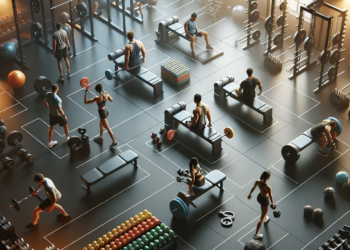Uncover the secrets to boosting your website’s ranking with internal linking strategies that will revolutionize your SEO approach.

Image courtesy of via DALL-E 3
Table of Contents
Welcome to a guide on SEO (Search Engine Optimization) and the importance of internal linking for your website. Imagine SEO like a secret code that helps your website get noticed by search engines like Google. When your website follows the SEO code correctly, it can appear higher in search results, making it easier for people to find. And one crucial part of this code is using internal links within your website.
What is SEO?
SEO is like a magic spell that helps your website reach more people when they search for something on the internet. By using the right words, images, and links, you can make your website more attractive to search engines, making it show up higher in the search results. It’s like waving a wand to make your website more visible!
What are Internal Links?
Internal links are like magical pathways within your website that connect different pages together. They help visitors navigate around your site easily by clicking on related topics or pages. These links also help search engines understand what your website is all about, making it more likely for your site to show up in search results when people are looking for information.
How Internal Linking Helps SEO
Improves Website Navigation
Internal linking is like a trail of breadcrumbs that helps visitors navigate through your website. When you click on a link, it takes you to another page on the same site. This makes it easy for people to find what they’re looking for without getting lost in the vast internet jungle.
Helps Search Engines Understand the Site
Think of internal links as signposts for search engines like Google. When they crawl through your website, these links tell them what each page is about and how they’re connected. By linking relevant pages together, you’re helping search engines understand the purpose and content of your site better.
Creating Effective Internal Links
When creating internal links within your website, it’s essential to use descriptive anchor text. This means using clear and relevant words that accurately represent the content of the page you are linking to. By doing so, you are not only helping users understand what to expect when they click on the link but also assisting search engines in understanding the context of the linked page.
Link to Relevant Content
Linking to relevant content is crucial for both user experience and SEO. When you link to related content within your website, you are helping visitors discover additional information that interests them, keeping them engaged and on your site longer. From an SEO perspective, linking to related content helps search engines establish the relevance of your website and can improve your rankings for related keywords.
Structures for Internal Linking
Imagine your website as a big book with different chapters and sections. The hierarchy structure is like the table of contents that helps organize all the information. By linking from one page to another in a structured way, you make it easy for visitors and search engines to navigate through your content.
Cluster Structure
Now, think of the cluster structure as grouping similar topics together. When you link related pages within a cluster, you create a web of interconnected information that shows search engines your expertise in a particular subject. This not only helps visitors find more relevant content but also signals to search engines that your website is an authority on the topic.
Common Mistakes and How to Avoid Them
One common mistake many website owners make is including an excessive number of internal links on their pages. While internal links are beneficial for SEO and user navigation, having too many can overwhelm visitors and even confuse search engines. It’s essential to find the right balance when incorporating internal links into your content.
Linking to Irrelevant Pages
Another mistake to avoid is linking to irrelevant pages within your website. When internal links direct users to content that is not closely related to their current interests, it can lead to a frustrating user experience and negatively impact your SEO efforts. Make sure to link to relevant pages that enhance the user’s understanding of the topic and keep them engaged on your site.
Monitoring and Updating Internal Links
After you’ve added internal links to your website, your work isn’t done! It’s essential to regularly go back and check those links to ensure they are still working correctly and leading visitors to the right places. Sometimes, web pages get moved or deleted, which can break your internal links. By conducting regular checks, you can identify and fix any broken links before they negatively impact your site.
Using Tools for Monitoring
To make this process easier, you can use various tools that help you monitor and track the health of your internal links. These tools can automatically check your site for broken links, analyze link performance, and provide insights on how to improve your internal linking strategy. By leveraging these tools, you can stay on top of your internal links without having to manually check each one individually.
Case Study: Successful Internal Linking
Let’s take a look at a website called “Healthy Eats Daily” that struggled with poor search engine rankings. Before implementing an effective internal linking strategy, their website was buried in search results, making it hard for users to find their valuable content.
Implemented Changes
After analyzing their site structure, “Healthy Eats Daily” revamped their internal linking strategy. They started by interlinking related articles with descriptive anchor text, making it easy for users to navigate from one topic to another. By creating a hierarchical structure, they were able to organize their content effectively.
Additionally, they focused on linking to relevant content within their website. If an article mentioned the benefits of a vegetarian diet, they made sure to link to other articles on vegetarian recipes, health benefits, and tips for beginners. This not only kept users engaged but also helped search engines understand the breadth of their content.
These simple yet strategic changes had a significant impact on their SEO. Within a few months, “Healthy Eats Daily” saw a noticeable improvement in their search engine rankings. Their website started appearing on the first page of search results for relevant keyword searches, driving more organic traffic and increasing user engagement.
Conclusion
In conclusion, internal linking is a vital strategy for improving SEO on websites. By including internal links throughout your site, you can enhance website navigation, help search engines understand your content better, and ultimately boost your site’s ranking on search engine results.
Final Thoughts:
As you continue to develop your website, remember the significance of strong internal linking practices. By using descriptive anchor text, linking to relevant content, and structuring your links effectively, you can create a seamless user experience and improve your SEO efforts. Don’t forget to monitor and update your internal links regularly to ensure their efficacy and check for any potential issues that may arise. By implementing these strategies, you can set your website up for success in the competitive world of online search.
Frequently Asked Questions (FAQs)
How many internal links should a page have?
Pages on a website can typically have anywhere from 2-6 internal links, depending on the length and depth of content. It’s important to strike a balance – too few links may limit navigation and SEO benefits, while too many links can overwhelm visitors and dilute the link equity passed. Consider the context and relevance of each link when deciding the appropriate number for a page.
Can internal linking hurt my SEO?
While internal linking is generally beneficial for SEO, it can potentially harm your website’s optimization if done incorrectly. Overuse of internal links or irrelevant linking to unrelated pages may confuse search engines about the site’s structure and content relevance. It’s essential to maintain a natural and user-friendly link strategy to avoid any negative impact on SEO performance.







